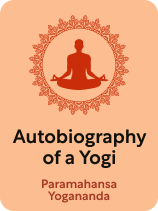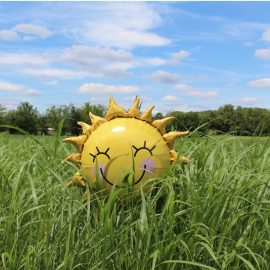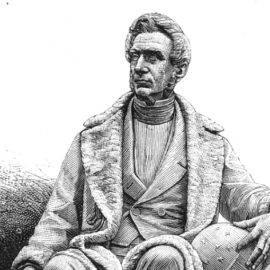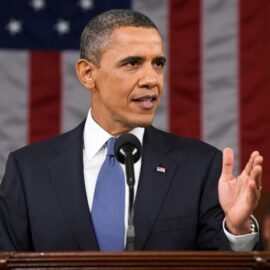

This article is an excerpt from the Shortform book guide to "Autobiography of a Yogi" by Paramahansa Yogananda. Shortform has the world's best summaries and analyses of books you should be reading.
Like this article? Sign up for a free trial here.
Want an overview of Autobiography of a Yogi by Paramahansa Yogananda? Who is Yogananda and what is he best known for?
Autobiography of a Yogi by Paramahansa Yogananda is a memoir of one of the world’s most famous yoga practitioners and teachers. Yogananda is best known for bringing kriya yoga to the US and thereby creating a spiritual connection between the West and India.
Read on for a brief overview Paramahansa Yogananda’s book Autobiography of a Yogi.
Paramahansa Yogananda: Autobiography of a Yogi
In Autobiography of a Yogi, Paramahansa Yogananda shares his memoirs as one of the world’s most famous yoga practitioners and teachers. It provides practical lessons about yoga, spirituality, and how to live a good life, interspersed with highlights and anecdotes from the author’s life. It was reportedly Steve Jobs’s favorite book: He found such great value in Autobiography of a Yogi that he read it once a year and had 500 copies distributed at his funeral.
Yogananda (1893-1952) is best known for bringing kriya yoga to the US—he taught thousands of American students and thereby created a spiritual connection between the West and his homeland of India. Yogananda also founded the Self-Realization Fellowship, a spiritual organization that now has over 500 locations globally. Between the schools he founded and the books he wrote, Yogananda ensured that his teachings reached millions of people all over the world.
What Is Yoga?
To better understand Paramahansa Yogananda’s life and his accomplishments, we’ll start by exploring some of yoga’s key beliefs and practices, according to the descriptions in Autobiography of a Yogi. Then, we’ll explain what distinguishes kriya from other forms of yoga.
Yogananda explains that yoga is a religious practice that originated in Hinduism. It’s linked to Hindu teachings surrounding illusion and reality. The Vedas (the oldest Hindu scriptures) describe God as the only reality in the universe—thus, Hinduism teaches that all physical things, including you as an individual being, are illusions. These illusions are collectively called maya.
The word yoga means “union with God.” Yoga is designed to help you recognize and reject maya while accepting God. In doing so, you stop thinking of yourself as an individual, and you instead become a conduit for God’s knowledge, will, and power. Someone who achieves this is said to be enlightened.
With enough training and spiritual growth, a yogi can break through the illusions of maya and enter a state called samadhi, where their individual consciousness temporarily merges with God. Yogananda describes samadhi as a state of perfect bliss and total awareness—a yogi who enters samadhi sees and experiences the entire universe all at once.
Yogananda says that the strength of a yogi’s connection with God is measured by the intensity of their bliss while in samadhi—stronger feelings of bliss indicate a stronger connection and therefore greater progress in yoga.
What Is Kriya Yoga?
In Autobiography of a Yogi, Paramahansa Yogananda explains that kriya yoga is a particular style of yoga that heavily emphasizes pranayama: breathing exercises and controlling your inner life energy (prana). All forms of yoga include pranayama, but not to the same extent as kriya.
Yogananda explains that these breathing exercises remove toxins from the blood, which allows life energy to flow more freely. You might picture pranayama as removing trash (toxins) that’s blocking the flow of a river (blood and life energy).
Once your life energy is flowing freely, Yogananda continues, you must then focus it around your central nervous system (spine and brain), which boosts your natural ability to perceive and understand God. In other words, these exercises are designed to help you reach enlightenment more quickly by strengthening your mind and body.
Yogananda’s Birth and Early Childhood
Paramahansa Yogananda notes in Autobiography of a Yogi that his birth was prophesied by a Bengali guru named Lahiri Mahasaya. The prophecy said that Yogananda would become a great yogi and undertake an important spiritual mission, though it didn’t specify what that mission would be.
The man who would become Paramahansa Yogananda was originally named Mukunda Lal Ghosh. He was born on January 5, 1893, in the city of Gorakhpur, India. (Shortform note: Although the author was known as Mukunda in childhood, this guide will refer to him as Yogananda throughout to avoid confusion.)
Even as a young child, Yogananda had frequent spiritual experiences, such as prophetic dreams and visions. He also demonstrated supernatural abilities, such as causing other children’s kites to fly over to him simply by exerting his will upon them. Furthermore, Yogananda remembered his previous lives.
Running Away From Home
Yogananda, eager to begin his spiritual training, frequently ran away from home. Each time, he planned to either look for a guru or to make a pilgrimage to the sacred Himalayan mountains.
However, no matter how many times he tried, he never made it far from home. Yogananda explains that he failed because it wasn’t the right time for him—his destined teacher hadn’t appeared yet, so God and fate blocked him from beginning his spiritual journey.
The Prophecy and the Amulet
In addition to foretelling Yogananda’s birth, Mahasaya gave a second prophecy: Yogananda’s mother would receive an amulet, which she would pass to Yogananda after her death. Yogananda would then carry the amulet—and when the amulet disappeared, it would be time for Yogananda to meet his guru.
The prophecy came true. Yogananda’s mother left the amulet to him when she died. It was one of Yogananda’s most precious possessions, and he kept it in a locked box, except for brief times when he wanted to look at it.
However, one day, Yogananda opened the box to find that the amulet was gone. That same day, seemingly by chance, he met Sri Yukteswar Giri—a swami who would become his guru.
Yogananda’s Education
To fulfill his destiny, Paramahansa Yogananda needed to learn a great deal about both the spiritual and the physical world. In this section, we’ll discuss his studies of kriya yoga with Sri Yukteswar, as well as the education he received at Calcutta University.
Sri Yukteswar: The Prophesied Teacher
Paramahansa Yogananda—still called Mukunda at the time—says in Autobiography of a Yogi that he and Yukteswar felt a spiritual connection before they even spoke to each other. Both of them knew immediately that they were destined to become student and teacher.
Yogananda says he lived and studied at Yukteswar’s ashram (religious community) from 1910 to 1920. Despite being his teacher, Yukteswar rarely told Yogananda what to do or directly answered his questions—instead, he offered gentle guidance and helped Yogananda find the answers himself.
In addition to offering spiritual training, Yukteswar taught the value of living and participating in daily life. Yukteswar had great respect for people with practical skills, from handymen to artisans.
Yogananda explains that this appreciation for the mundane was unusual for a spiritual leader like Yukteswar. However, it provided his students with a more well-rounded education and a better understanding of the world. This is important because understanding the physical world is a key step toward understanding that the physical isn’t real—a core tenet of Hinduism—and thereby reaching enlightenment.
After Yogananda completed his training, Yukteswar initiated him into the Swami Order. Ordinarily, the initiate’s guru chooses a new name for him to reflect his spiritual journey or some exceptional quality he displays. However, with his characteristic emphasis on gentle guidance, Yukteswar simply told Yogananda to choose his own name. This was when he took the name Yogananda, meaning “bliss through union with God.”
Yogananda’s Worldly Education
In addition to receiving training in kriya yoga, Yogananda earned a Bachelor of Arts degree from Calcutta University in 1915. Yukteswar had encouraged him to go to university; he’d foreseen that Yogananda would teach yoga in America and said that Westerners would listen more readily to somebody with a degree.
However, though he did get his degree, Yogananda says that he was always too focused on his spiritual training to study. In fact, he only passed his final exams by a series of seemingly impossible coincidences.
For example, Yogananda had a friend make up questions about the exam material to quiz him, and then those same questions appeared—nearly word for word—on the finals. On another exam, he failed to answer so many questions that it should’ve been impossible for him to pass, but the passing grade for that subject was unexpectedly lower that same year.
Yogananda says that these strokes of luck weren’t actually luck at all, but were due to the spiritual power of yoga. In other words, he believes that God helped him shape events to his benefit so that he would graduate.
Yogananda Passes on His Knowledge
Paramahansa Yogananda had become an accomplished yogi, but his mission in life was far from over—according to Autobiography of a Yogi, he’s remembered as a great teacher, not just a great practitioner of yoga. In this section, we’ll discuss the schools Yogananda founded and his legacy.
Yogananda says that, throughout his life, he’d received visions of three different buildings. While studying with Yukteswar, he came to understand that these were three schools he would found.
The first third of his vision came true when he founded the Yogoda Satsanga Society of India in 1917, near the city of Ranchi. However, it would be many years before the other two schools from his visions became reality.
Yogananda says that his schools combined spiritual and practical education, much like his own training with Yukteswar did. The school in Ranchi, for example, taught students academic subjects like math and literature, along with offering classes in agriculture, industrial job training, and business.
Even when teaching yoga, Yogananda couched his lessons in practical terms—he taught what he calls the science of kriya yoga, which explains yoga’s seemingly impossible effects using biology and physics. For example, he taught that the human body functions much like a battery; certain yoga techniques connect you with God’s infinite energy to recharge that battery, thereby explaining why some yogis don’t seem to need sleep.
Sri Yukteswar foretold that this well-rounded approach to teaching yoga would bridge the gap between Eastern and Western cultures—people who would normally be skeptical about spiritual practices would listen to a college-educated man explaining those practices and their benefits in scientific terms.
The End of Yogananda’s Life
Paramahansa Yogananda ends Autobiography of a Yogi in 1945, at the end of World War II. He explains that he and the other residents of the Encinitas ashram came together to thank God for bringing peace and pray that the world would never know such strife again. Yogananda looked at the assembled yogis and remarked that he—a monk sworn to celibacy—had been blessed with an enormous family.
Yogananda died in 1952. His funeral service, held in Los Angeles, attracted hundreds of people who came to pay their last respects to the great teacher and spiritual leader.

———End of Preview———
Like what you just read? Read the rest of the world's best book summary and analysis of Paramahansa Yogananda's "Autobiography of a Yogi" at Shortform.
Here's what you'll find in our full Autobiography of a Yogi summary:
- The memoir of Paramahansa Yogananda, a famous yoga practitioner and teacher
- Practical lessons about yoga, spirituality, and how to live a good life
- An explanation of the Eightfold Path of Yoga






